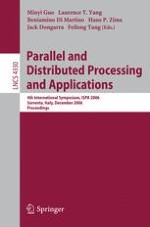Welcome to the proceedings of the 4th International Symposium on Parallel and Distributed Processing and Applications (ISPA 2006), which was held in Sorrento, Italy, December, 4–6 2006. Parallel computing has become a mainstream research area in computer s- ence and the ISPA conference has become one of the premier forums for the p- sentation of new and exciting research on all aspects of parallel and distributed computing. We are pleased to present the proceedings for ISPA 2006, which comprises a collection of excellent technical papers and keynote speeches. The accepted papers cover a wide range of exciting topics including architectures, languages, algorithms, software, networking and applications. The conference continues to grow and this year a record total of 277 ma- scriptsweresubmitted forconsiderationbytheProgramCommittee.Fromthese submissions the Program Committee selected only 79 regular papers in the p- gram, which re?ects the acceptance rate as 28%. An additional 10 workshops complemented the outstanding paper sessions. The submission and review process worked as follows. Each submission was assigned to at least three Program Committee members for review. Each P- gram Committee member prepared a single review for each assigned paper or assigned a paper to an outside reviewer for review. In addition, the Program Chairs and Program Vice-Chairs read the papers when a con?icting review - sult occurred. Finally, after much discussion among the Program Chairs and ProgramVice-Chairs, based on the review scores, the ProgramChairs made the ?nal decision. Given the large number of submissions, each ProgramCommittee member was assigned roughly 7–12 papers.
